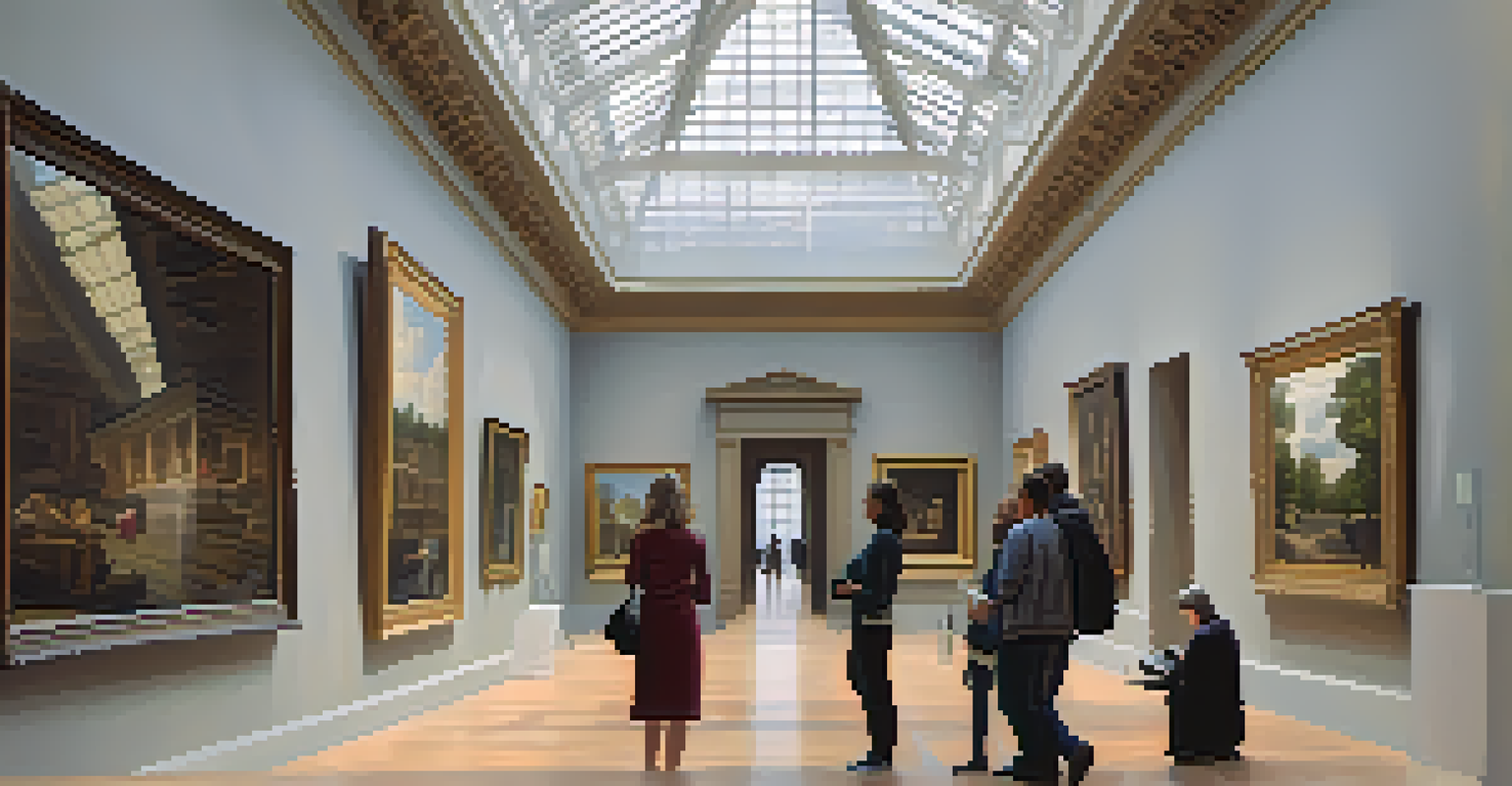Galleries as Platforms for Social Commentary in Painting

The Role of Galleries in Art and Society
Galleries serve as vital spaces for showcasing art, but their influence extends beyond aesthetics. They act as mirrors, reflecting societal issues and sparking conversations. Through curated exhibitions, galleries create a dialogue between the artist's perspective and the viewer's interpretation.
Art is the most beautiful of all lies.
By offering a platform for diverse voices, galleries contribute to a richer cultural narrative. They highlight underrepresented artists and themes, encouraging audiences to explore new ideas and perspectives. This engagement fosters a sense of community and shared understanding among visitors.
Ultimately, galleries can shape public perception and awareness, making them essential players in the art world. They not only display art but also challenge norms and stimulate critical thought about pressing social matters.
Art as a Catalyst for Social Change
Art has the unique ability to inspire change, and galleries are at the forefront of this movement. When paintings address social issues, they resonate deeply with viewers, often eliciting emotional responses. This connection can lead to greater awareness and action regarding various causes, from climate change to social justice.

For instance, consider how artists have tackled themes like immigration or inequality through their work. These poignant pieces often find a home in galleries, where they can reach a wide audience. The emotional weight of such artworks can motivate people to learn more and get involved in advocacy efforts.
Galleries Reflect Societal Issues
Galleries not only showcase art but also create dialogues that reflect and challenge societal norms.
In this way, galleries become not just exhibition spaces but also arenas for activism. They provide a platform for artists to voice their concerns and for audiences to engage with important social issues on a personal level.
Historical Context of Social Commentary in Art
Throughout history, art has been used as a form of social commentary, with galleries showcasing pieces that reflect the times. From the politically charged paintings of the Renaissance to the powerful works of the Harlem Renaissance, artists have always held a mirror to society. This tradition continues today, with contemporary artists addressing modern dilemmas through their craft.
The role of the artist is to ask questions, not to answer them.
Galleries play a crucial role in preserving this legacy by featuring works that challenge societal norms and provoke thought. They not only highlight historical pieces but also emphasize the ongoing relevance of art in societal discourse. By doing so, they remind us that art is not static; it's a living dialogue that evolves with our world.
Understanding this historical context enriches our appreciation of contemporary art. It underscores the importance of galleries in fostering a connection between past and present social issues, reminding us that the struggle for change is ongoing.
Case Studies: Galleries Leading the Charge
Numerous galleries around the world have made headlines by championing social commentary in art. For example, the Tate Modern in London frequently hosts exhibitions that tackle themes like identity, migration, and inequality. These shows often feature both established and emerging artists, creating a platform for diverse narratives.
Another notable space, the Museum of Contemporary Art in Chicago, has made it their mission to amplify voices from marginalized communities. Their exhibitions often explore issues such as race, gender, and class, inviting audiences to engage with these critical topics. Such initiatives demonstrate how galleries can influence public discourse and promote social awareness.
Art Inspires Social Change
Art serves as a powerful catalyst for social change, with galleries providing a platform for artists to address pressing issues.
These case studies illustrate that galleries are not merely passive observers; they actively shape the conversation around art and society. By prioritizing social commentary, these institutions inspire both artists and audiences to think critically about the world around them.
The Impact of Digital Galleries on Social Commentary
In today's digital age, online galleries have emerged as powerful platforms for social commentary. They provide artists with a global stage, allowing their work to reach audiences far beyond traditional gallery walls. This accessibility can amplify important messages and foster a sense of community among viewers across the globe.
Digital galleries often feature interactive elements, encouraging viewers to engage more deeply with the artwork. This can lead to discussions and shared experiences, making the commentary even more impactful. Artists can use social media to promote their work, attracting attention to social issues that matter to them.
As a result, the digital realm has become a vital space for artistic expression and social critique. This shift not only democratizes art but also enhances its potential to inspire change, showing how galleries can adapt to the evolving landscape of communication.
Challenges Facing Galleries in Promoting Social Commentary
While galleries play a significant role in social commentary, they also face challenges in promoting these themes. One major hurdle is the risk of commercial pressures that might prioritize marketability over meaningful content. This can lead to a dilution of important messages in favor of more palatable artworks that attract larger audiences.
Additionally, galleries must navigate the fine line between artistic expression and social responsibility. They need to ensure that they are not merely appropriating social issues for profit but genuinely supporting the artists and causes they represent. This requires a thoughtful approach to curation and a commitment to ethical practices.
Digital Platforms Enhance Engagement
The rise of digital galleries allows for broader accessibility and engagement with social commentary, reaching global audiences.
Despite these challenges, many galleries are finding innovative ways to maintain their focus on social commentary. By fostering relationships with artists and communities, they can create an environment where art serves as a vehicle for change while also being commercially viable.
The Future of Galleries and Social Commentary in Art
Looking ahead, the future of galleries as platforms for social commentary appears promising. As societal issues continue to evolve, so too will the themes explored in art. Galleries are likely to become even more engaged with pressing concerns, reflecting the dynamic nature of our world.
Moreover, the rise of virtual reality and immersive experiences may transform how galleries present social commentary. These technologies can create engaging environments that draw viewers deeper into the narratives behind the art, enhancing their understanding and emotional connection.

Ultimately, as galleries adapt to new trends and challenges, their role in promoting social commentary will remain vital. By championing diverse voices and fostering critical dialogue, they will continue to be essential spaces for reflection, inspiration, and change.